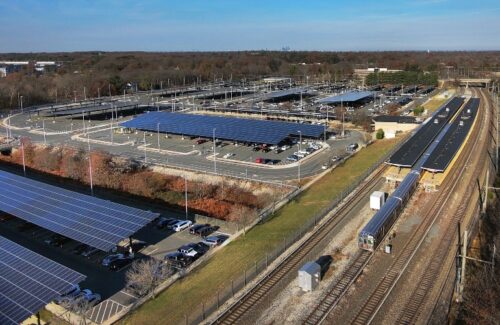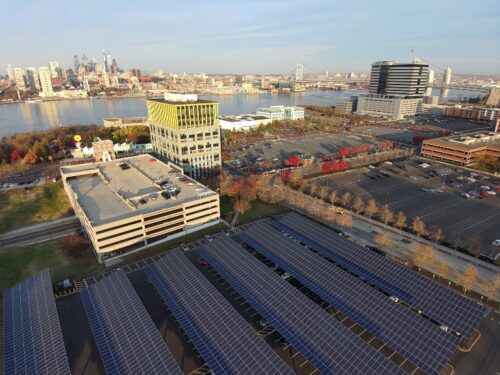The PATCO Speedline is a 15-mile-long high-speed commuter train responsible for transporting millions of people between Philadelphia, Pennsylvania, and Camden County, New Jersey, annually. Like many modern commuter rail lines, PATCO Speedline uses an electrified third rail to power its locomotive cars. A robust behind-the-meter solar portfolio is responsible for most of that power.

Credit: The Delaware River Port Authority
The Delaware River Port Authority (DRPA) is a bi-state transit agency responsible for maintaining four bridges crossing the Delaware River that connect New Jersey and Pennsylvania near Philadelphia. It is also the parent company of the Port Authority Transit Corporation, which operates the PATCO Speedline.
In 2018, the DRPA commissioned a 22-MW solar portfolio built across seven different sites in its New Jersey territory that is now powering the PATCO Speedline. The six carports and one rooftop array started commercial operations in April 2022. While using solar to power electric trains isn’t a new concept globally, this project is the first and largest in the Northeast United States that is not grid-tied, and instead supplies power directly to the rail line.
“We committed ourselves to the idea of stewardship,” said John Hanson, CEO of DRPA and president of PATCO. “Stewardship is at the center of our mission and our vision. Environmental stewardship makes sense, because we’ve got these four bridges that span a very complex and biodiverse ecosystem in the Delaware River, and this mass transit line, which is hopefully contributing to positive environmental effects.”
Powering the third rail with solar
Back in 2017, the DRPA conducted a feasibility assessment for solar construction on its properties between Pennsylvania and New Jersey. The port authority had prior experience with energy efficiency measures, such as upgrading to LED lighting, but not with solar energy. Given the electrified nature of the PATCO Speedline and its high energy load, the DRPA started seriously considering solar as an energy source.
Looking at its train stations, bridges and headquarters throughout the region, the DRPA opted to develop sites east of the Delaware River because New Jersey offered renewable energy credits and Pennsylvania did not.
“For the money to make sense, New Jersey has really strong renewable energy credits, and Pennsylvania, at the time, did not have that,” said Nicole Ochroch, senior engineer at the DRPA. “It just wasn’t making sense at the time to look into Pennsylvania.”
The DRPA issued a request for proposals for the solar project in 2018 and selected SunPower Commercial & Industrial Solutions prior to its acquisition by TotalEnergies in early 2022. The groups arranged a 20-year power purchase agreement on the project, with TotalEnergies responsible for designing, building, operating and maintaining the arrays for the duration of the PPA.
The arrays were designed throughout 2019 and construction began in May 2020 — two months after the COVID-19 lockdown.
“It actually worked in our benefit, to be honest. We are a transportation agency and right at the beginning, we were given the opportunity to continue our construction projects because we were vital to the region,” Ochroch said. “As such, we were actually able to expedite a lot of our construction in our public-facing areas because the parking lots at our PATCO stations, which is where we have our solar systems, weren’t being used.”

Credit: The Delaware River Port Authority
There are seven solar arrays installed across the DRPA’s properties in New Jersey. Four carports are installed on four different PATCO lots, accounting for 20 MW of the total project size. A small carport is installed at the Betsy Ross Bridge; another covers the employee parking lot at One Port Center, the DRPA’s headquarters; and the final system is a rooftop array at the Commodore Barry Bridge. Altogether, there are more than 50,000 solar panels installed across the seven sites.
Working with the former SunPower installation team meant the hardware used on the system was mostly first-party. The arrays are composed of SunPower X-Series and E-Series solar panels, Helix Carport racking and Delta inverters. The systems did require some modifications to tie directly into traction power connections of the PATCO Speedline that aren’t found on grid-tied systems.
“The technology is pretty much the same, but the safety mechanisms and our SCADA systems had to be really tuned in to understand what’s happening on the PATCO side and how that interfaces with the solar systems so that there’s no back-feeding,” Ochroch said. “We have multiple layers of safety elements built in, which is definitely more than what is traditional in a typical carport system.”
Running directly to the train line in seven different locations meant different wiring considerations for each site. Mike Venuto, chief engineer at the DPRA, said PATCO locations and the rail line weren’t always considered contiguous parcels, so months were spent arranging easement approvals from other property owners and transit authorities to run these strings.
“The other challenge was when we were putting it all together, you’re working in and around a live train line, and our PATCO system operates 24 hours a day, seven days a week, 365 days a year,” he said. “So, something as simple as going under the tracks or pulling wires across the tracks…takes a lot of coordination to do.”
PATCO Speedline provides a service to millions of commuters in New Jersey and Pennsylvania. While public transit is subsidized, the DRPA still strives to keep the cost of train fares down. With the addition of solar, the DRPA is covering about half of its electrical needs, which has resulted in substantial savings for both the agency and commuters.
“Cutting costs enables us to keep our costs low and to put off fare increases for longer periods of time,” Hanson said. “In fact, right now we’re nearly 12 years without a toll increase or a fare increase because of the financial stewardship that we’ve engaged with here, and this project rings both bells. It’s financial stewardship and environmental stewardship.”





Tell Us What You Think!